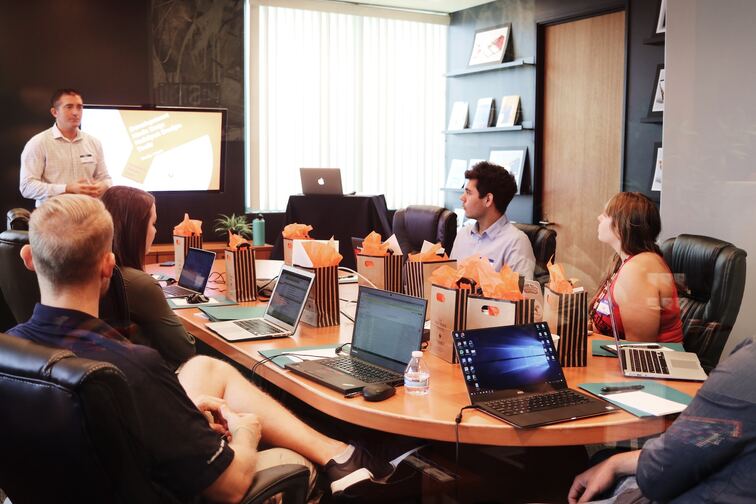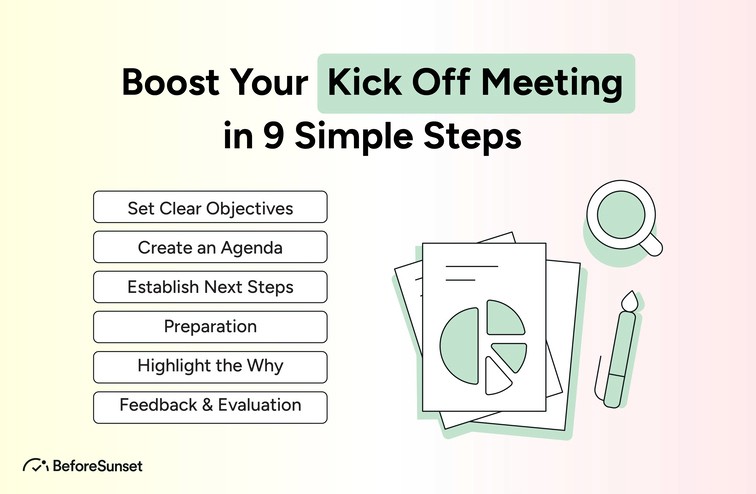Any project's ability to succeed depends on its foundation, and kick-off meetings are frequently the first step in creating that foundation. A well-planned kick-off meeting may establish the atmosphere, lay out expectations, and bring the team together behind a single objective.
It's the starting point of your project, thus doing it well is crucial. We'll go over nine easy actions in this blog to make your kick-off meeting more productive and vibrant so you can accomplish the goals of your project.
These steps will assist you in maximizing the potential of a well-conducted kick-off meeting, regardless of experience level or experience level, therefore laying the groundwork for a successful project from the outset.

How To Boost Your Kick-Off Meeting
Any project's ability to succeed, no matter how big or little, frequently depends on how solid its foundation is. Within the field of project management, this groundwork is established at the crucial stage called the kick-off meeting.
Your project begins with this first meeting, where the seeds of inspiration, cooperation, and clarity are sowed. While a poor kick-off meeting can result in misunderstandings, misalignment, and expensive setbacks, an excellent one can lay the groundwork for a seamless and prosperous project.
1. Define Clear Objectives:
Establishing SMART (specific, measurable, attainable, relevant, and time-bound) goals that are in line with the aims and purpose of the project can help to improve the clarity of your objectives and kick off meeting.
Gaining a comprehensive grasp of the project and its stakeholders is the first step in this approach. Prioritizing, communicating, discussing, and fine-tuning SMART objectives during the meeting, as well as documenting them for each participant, should all be part of the process.
Assigning duties establishes responsibility, and the project stays on course with frequent goal reviews. By defining these goals, your kick-off meeting becomes a hub for common understanding and purpose, which increases the meeting's efficacy in getting the project off the ground.

2. Prepare an Agenda:
Creating an agenda is essential to a well-run, productive meeting. It acts as a schedule, detailing the subjects, conversations, and exercises that will occur throughout the gathering. A well-organized agenda makes the meeting more effective by guaranteeing that all important topics are covered and helps to keep the discussion on course.
Greetings and introductions usually open the agenda, which is then followed by a summary of the project's goals and objectives, an explanation of roles and duties, the project timeline, a discussion of the communication strategy, a risk assessment, and an opportunity for questions and concerns to be raised.
The agenda ends with a series of action items that outline the next steps to be taken and assign accountability for each job. This extensive schedule guarantees that the kick-off meeting offers a precise, targeted, and goal-oriented beginning to the project.
3. Invite the Right People:
Determine Key Stakeholders: To start, list the main decision-makers, stakeholders, and team members who are directly involved in the project. These people must be there to offer suggestions, make choices, and comprehend the goals of the project.
Consider Relevance: Assess each prospective participant's significance. Do they have a major interest or area of expertise to contribute, or are they actively involved in the project? If not, think about whether they really need to be there.
Prevent Overcrowding: Although having important people in attendance is essential, try not to pack the meeting with extra people. A group that is too big may be less engaged and inefficient.
Client or End-User Involvement: If there are outside customers or end users involved in the project, think about inviting them in order to make sure their expectations line up with the goals and deliverables of the project.
Supporting Roles: Invite people in supporting positions, including subject matter experts, who may offer insightful advice or important insights, in addition to the main team members.
Use Clear Invitations: Ensure that the goal of the gathering is made clear in the invites you send out. Give a succinct schedule and stress the value of the contributions made by the attendees.
Confirmation: Get in touch with attendees to make sure they're coming and to let them know how important the meeting is so they can be ready.

4. Set a Date and Time:
A crucial element of the success of your kick-off meeting is choosing the appropriate day and time. It entails giving several issues significant thought. To guarantee that all crucial stakeholders can participate, the date should be selected in accordance with project milestones, client availability, and team member schedules.
The participants' time zones, working hours, and any potential conflicts with other significant obligations should all be considered when choosing the timeframe. It might be difficult to find a time that works for everyone and doesn't conflict with project deadlines, but it's crucial to increase involvement and attendance.
Moreover, having a well-attended and productive kick-off meeting helps to establish a solid basis for the project. This may be achieved by clearly communicating the date and time of the meeting and sending out reminders.
5. Choose the Right Location:
Selecting the ideal venue for your first meeting is essential, especially when considering both in-person and virtual meetings. When holding an in-person meeting, the venue should be conveniently reachable by all attendees to minimize travel disruptions.
In order to facilitate productive presentations and conversations, it should also offer the facilities and technology required, such as projectors, displays, and audio equipment. Choosing the appropriate platform for virtual meetings is crucial, taking into account aspects such as accessibility, interoperability, and capabilities for screen sharing, video conferencing, and collaboration.
To avoid interruptions, it's also essential to have a dependable internet connection for virtual meetings. Both physical and virtual spaces should be welcoming and able to foster fruitful interactions that keep participants interested and concentrated.
An efficient kick-off meeting is facilitated by a well-chosen setting, which also helps participants communicate and work together more effectively.

6. Prep Materials and Technology:
Setting up the technology and resources for your kick-off meeting is essential to a successful and memorable event. As part of this process, it is important to make sure that all required materials—including handouts, paperwork, and presentation materials—are ready and available to presenters and participants.
In addition, any technical tools or platforms that will be utilized in the meeting—such as projectors, displays, audio-visual equipment, and video conferencing software—must be carefully tested and set up in the current digital era.
By making sure everyone is comfortable with these tools and that they are in good functioning order, last-minute technological difficulties may be avoided, allowing the meeting to remain focused on the topics and conversations.
A professional and effective kick-off meeting is enhanced by the proper set up of materials and technology, which facilitates the smooth flow of information and creates an atmosphere that is both engaged and productive.
7. Engage Participants:
The effectiveness of your kick-off meeting depends on how well you engage the attendees. Engaging participants early on fosters teamwork, support, and a feeling of project ownership. To do this, think about including interactive components that promote involvement, such as surveys, open conversations, and icebreakers.
Presentations may become more lively and relevant by including multimedia and captivating images. Throughout the meeting, invite attendees to contribute, ask questions, and share their thoughts in order to provide a forum for their ideas and worries.
Encouraging participation increases team members' enthusiasm and dedication while also ensuring that everyone is on the same page. Your kick-off meeting becomes a lively and successful launchpad for your project or endeavor if you can maintain participant engagement.

8. Present Information Effectively:
Effective information presentation is crucial to making sure attendees understand and remember important topics during your kick-off meeting. Infographics, charts, and neatly arranged presentations are examples of visual aids that may help make difficult material easier to understand and more palatable.
It's important to utilize concise, understandable language; and stay away from jargon and superfluous technical phrases that might mislead people. Maintaining interest and comprehension during presentations may be facilitated by organizing them rationally, beginning with an overview and then going into more detail.
To help the material become more accessible and remembered, think about using anecdotes and examples from real-world experiences. In addition to improving comprehension, well-presented material also makes it easier for participants to put the knowledge to use and actively participate in the project's success.
9. Assign Action Items:
Effective information presentation is crucial to making sure attendees understand and remember important topics during your kick-off meeting. Infographics, charts, and neatly arranged presentations are examples of visual aids that may help make difficult material easier to understand and more palatable.
It's important to utilize concise, understandable language; and stay away from jargon and superfluous technical phrases that might mislead people. Maintaining interest and comprehension during presentations may be facilitated by organizing them rationally, beginning with an overview and then going into more detail.
To help the material become more accessible and remembered, think about using anecdotes and examples from real-world experiences. In addition to improving comprehension, well-presented material also makes it easier for participants to put the knowledge to use and actively participate in the project's success.

During the Meeting
A crucial part of the conference occurs during which choices are taken, plans are implemented, and teamwork is prioritized. It is the dynamic center of your endeavor, where members' combined efforts come to life and ideas are turned into deeds. The pillars of this phase are deliberate execution, active involvement, and effective communication.
Introducing Team Members & Assigning Roles & Responsibilities
One of the most important stages in the project management process is introducing team members and delegating tasks. This stage guarantees that all participants are aware of their responsibilities and contributions to the project and lays the groundwork for productive teamwork.
Each team member should be introduced at this phase, emphasizing their background, experience, and planned contribution to the project. It is equally important to provide distinct roles to team members. This helps to avoid confusion or overlaps by outlining expectations for each person.
As a result of this phase, team members are more united and have a greater sense of purpose, which helps the project succeed by bringing everyone on board with the same vision and objectives. To make sure that everyone is aware of their function and the roles of their colleagues, effective communication and openness are essential components of this process.
Outlining Project Overview, Goals and Objectives
A crucial part of project management is creating an overview, goals, and objectives document that establishes the overall direction and purpose of the project. The project's essential elements, such as its background, scope, and importance, are provided in this phase.
The broad, high-level aspirations of the project are defined by its goals, which are then followed by precise objectives that offer a thorough and quantifiable plan for reaching those goals. This stage ensures that team members and stakeholders have a common understanding and forms the basis for all project decisions and activities.
It gives a clear framework for assessing the project's progress and keeps it in line with its stated goals. During this stage, it's critical to communicate clearly and effectively to ensure that all parties understand and support the project's mission, goals, and objectives.

Discussing External Stakeholders & Their Expectations
Since it recognizes the influence of people or organizations outside of the immediate project team, talking about external stakeholders and their expectations is an essential part of project management. Clients, consumers, suppliers, regulators, and members of the community who are impacted by the project's results can all be considered external stakeholders.
The project team and stakeholders undertake open discussions to determine, record, and comprehend the needs, specifications, and expectations of outside parties during this phase. You may make sure that the project is in line with the interests of external stakeholders and raise the possibility that they will support it by addressing these expectations early on.
This stage fosters openness, confidence, and efficient communication—all of which are necessary for maintaining connections with outside parties and accomplishing the project's objectives while taking the organization's or community's wider effects into account.
Explaining Timeline, Key Deliverables, Milestones & Deadlines
Timeline: The timeline sets the project's schedule, indicating the start and end dates, as well as the durations of various project phases or activities. It outlines the project's temporal framework, helping all stakeholders understand when work is expected to occur.
Key Deliverables: These are the primary, tangible results or outputs of the project. Each deliverable is a critical element that contributes to achieving the project's objectives. Explaining key deliverables helps the team and stakeholders understand what specific outcomes to expect.
Milestones: Milestones are significant events or achievements within the project timeline. They act as signposts that indicate progress and mark the completion of essential phases or tasks. Milestones are crucial for monitoring and ensuring the project stays on track.
Deadlines: Deadlines are specific dates or times by which certain tasks or deliverables must be completed. They provide a sense of urgency and accountability, driving the team to meet time-sensitive goals.
BeforeSunset AI Where Teams Unite
Achieve your daily goals distraction-free. BeforeSunset AI Teams version lets you sync with your team's tasks, work asynchronously, and use analytics to boost team performance, preventing burnout. Stay on track, together.


